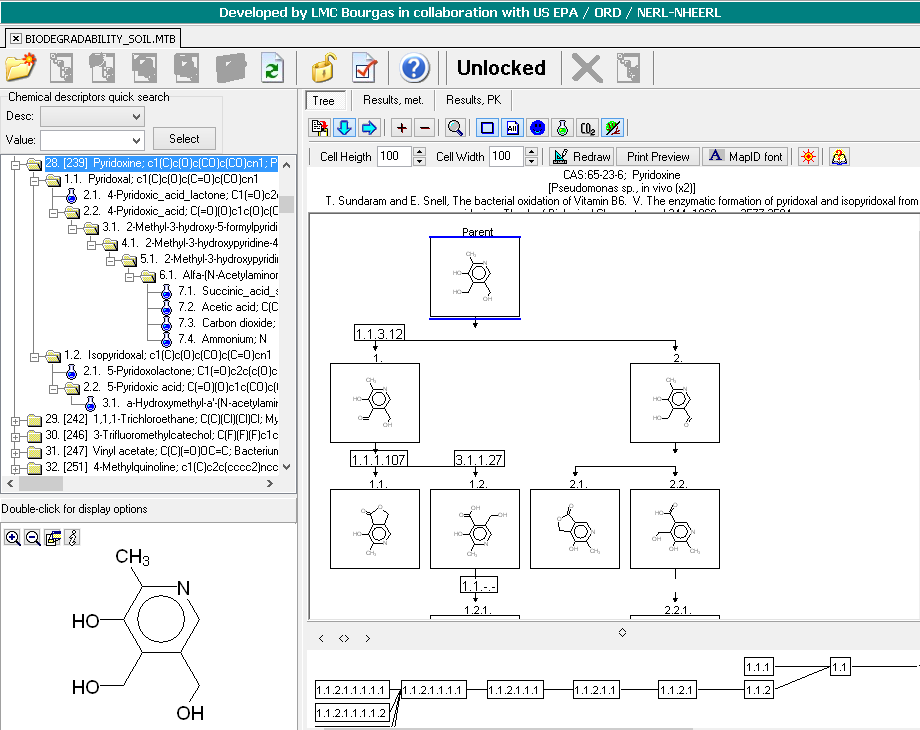Microbial Degradation in Soil Database
The Soil Biodegradation database was created and is maintained by LMC. Data were collected from different sources: monographs, scientific papers, internet resources [1 - 11].
Chemical Identification
Parent chemicals are defined with CAS, SMILES and chemical name(s), while metabolites are described with SMILES and chemical name(s). For each parent chemical there is a catabolic map presenting the biotransformations leading to occurrence of the observed metabolites. When the transformation is activated by enzyme or class of enzymes a corresponding indication is added to the map. Along with biotransformations each map is accompanied with additional supporting information - test species details, experimental conditions, sampling and processing methods, dosing information, etc.
Content
The database contains 318 documented metabolic maps for 301 unique parent chemicals with observed catabolic pathways of various compounds, mostly pesticides, fungicides and herbicides in terrestrial conditions. Every map is accompanied with rich collection of chemical, transformation and experimental data. Test variations are represented as different treatment groups (studies) that show the influence of various experimental conditions on the occurrence of each metabolite. This results in 232 studies, which can be categorized by various criteria. For example, the species distribution is as follows:
- Bacteria - 36%,
- Microorganisms - 60%,
- Fungi - 4%.
References
1. Microbial Degradation of Organic Compounds Microbiology series, v. 13 (Ed. by D. T. Gibson), Marcel Dekker, Inc., N. Y. 1984
2. Aizawa, H., Metabolic Maps of Pesticides: Ecotoxicology and Environmental Quality Series, Academic Press, New York, 1982
3. Aizawa, H., Metabolic Maps: Pesticides, Environmentally Relevant Molecules and Biologically Active Molecules, Academic Press, San Diego, 2001
4. ECT Oekotoxikologie GmbH, DE
5. Pesticides: Benefaction or Pandora 's Box? A synopsis of the environmental aspects of 243 pesticides, J. B. H. J. Linders, J. W. Jansma, B. J. W. G. Mensink, K. Otermann, Report no 679101014, March 1994
6. Bondar, V. S., M. G. Boersma, E. L. Golovlev, J. Vervoort, W. J. H. Van Berkel, et al. Biodegradation, vol. 9 (1998)
7. Diaz, E., A. Ferrandez, M. Prieto, J. Garcia, Microbiology and Molecular Biology Reviews, v.65, (2001)
8. Johansen, S. S., D. Licht, E. Aruin, H. Mosbaet, A.B. Hansen, Appl. Microbiol. Biotechnol., 47, N3, 1997
9. Komancova, M., I. Jurcova, L. Kochankova, J. Burkhard, Chemosphere, 50 (2003)
10. The University of Minnesota Biocatalysis / Biodegradation Database (http://umbbd.ethz.ch/)
11. Metabolic Pathways of Agrochemicals, Part 2: Insecticides and Fungicides (Ed. by T.R.Roberts and D.H. Hutson) The Royal Soc. of Chemistry Cambridge, U.K., 1999

